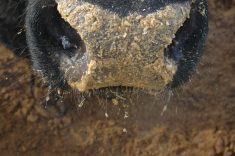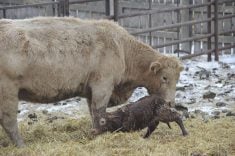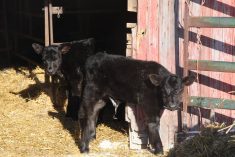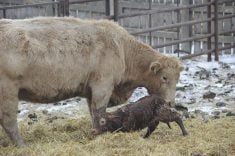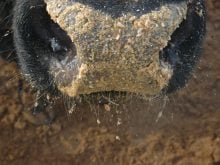Any injury to the testicles that damages stored sperm may put a bull out of action until it heals and produces new sperm
Scrotal frostbite in bulls is a risk to fertility and ranch profitability.
Cold weather and wind chill can damage bulls’ testicles and deteriorate semen but it is hard to gauge without a test.
Dr. Colin Palmer, associate director at the Livestock and Forage Centre of Excellence at the University of Saskatchewan, says scrotal frostbite commonly occurs in bulls after a severe winter, particularly when they don’t have adequate bedding or shelter from wind. Even then, they may have to graze or eat hay in the open, exposed to wind.
“If bulls are out at pasture and you are feeding hay, try to find a sheltered area to feed them, such as rolling a bale down into a coulee rather than spreading it out on a windswept open space,” he says.
The scrotum has little protection compared with the rest of the bull’s body. It’s basically bare skin with a fine hair covering. If bulls lie on frozen ground or snow, it’s like putting the testes on ice. Bedding can serve as insulation when bulls are lying down.
“Another thing I tell producers is to pay attention to bull social dynamics,” says Palmer.
“Maybe they put a bunch of bulls in a large pasture for winter. Social dominance is usually determined by age and size. The older bulls are generally dominant and may keep the younger ones away from the feed, bedding or shelter.
“If they have lots of room, the young bull can avoid the older bulls and stay out of their way, but he may not have a place to bed or get out of the wind if those spaces are limited.”
Some bulls get frostbite even with good care and bedding. Palmer says these bulls usually have large, pendulous scrotums that hang down lower and are more exposed to the wind. In cold weather, a bull normally pulls its testicles closer to the body for warmth, but older bulls with pendulous scrotums may be unable to do that.
“Frostbite and freezing of the tissue results in inflammation, which produces heat and swelling, which interferes with the cooling and warming mechanism of the testicles. If the inflammation and its subsequent repair is severe enough, the testicles are no longer able to move freely in the scrotum,” says Palmer.
The bull then can’t raise or lower the testicles to maintain the proper temperature for sperm production.
“In early phases after frostbite, semen quality is adversely affected due to the inflammation. But we can check those bulls later, as they heal.
“As long as the testicles are freely moveable, we can follow up on that bull and see if he passes a breeding soundness exam, with viable sperm. I have seen some alarming cases of frostbite that looked bad, but the testicles were freely moveable, and it didn’t seem to adversely affect semen quality, and both testicles were still of similar size.
“There should be no more than 10 percent difference in a pair of testicles. I have been amazed that some of these bulls recover,” he says.
It takes about 60 days to create viable sperm. Any injury to the testicles that damages stored sperm may put a bull out of business until the injury heals and new sperm are produced.
If frostbite damage occurs, it will be at least two months before the bull will have viable sperm and may be longer depending on severity.
“If you have your bull tested and the vet discovers severe scrotal frostbite and only 30 percent of his sperm are normal, and you need him next week, that bull is not likely going to work for this breeding season,” says Palmer.
“It takes two months to form sperm cells, plus another 11 days in the epididymis where they continue to mature.”
If the damage occurs in January or February and the bull isn’t needed until June or July, the bull may be fully recovered.
Palmer says frostbite can be severe enough to cause testicular degeneration.
“When the testicles shrink in size, they stop producing sperm. The tissues with all the little ducts shrink up and the testicles shrink. If it’s permanent degeneration, much of that testicular tissue is replaced with scar tissue.”

In that case, the bull’s ability to produce normal sperm will not recover.
Frostbite can be visually evident, with scabs on the back and bottom of the scrotum, and should prompt a producer to have bulls checked before next breeding season.
“With frostbite, the testicles may not be freely moveable, and/or the bull may have a temporary insult to spermatogenesis or something more serious that could take him out of action permanently,” Palmer says.
However, scrotal frostbite can be deceiving.
“A bull might have a very large scab that’s superficial. It looks bad but isn’t affecting him much. Or, he might have deeper damage that’s not as obvious.
“Maybe there was trauma associated with it; maybe while he couldn’t pull his testicles up, those low-hanging testicles suffered additional injury. A relatively minor scab might be accompanied by deeper damage.”





